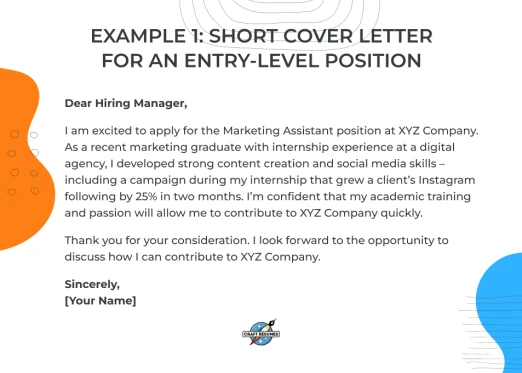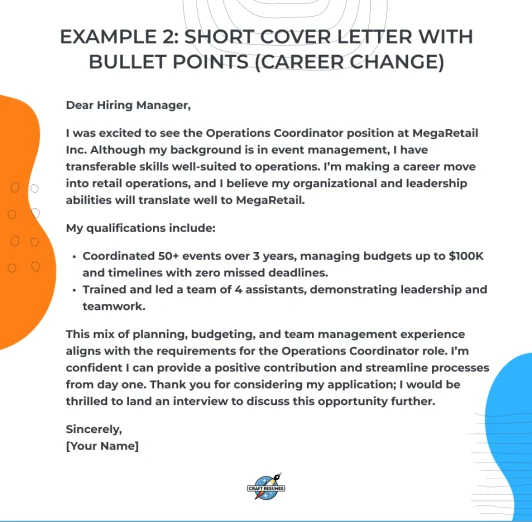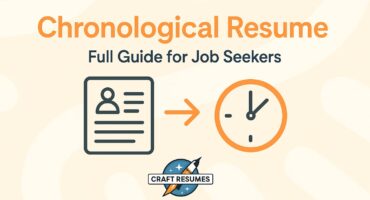Short Cover Letter Examples: Effective Writing Strategies for Job Seekers
May 30 2025
Hiring managers move fast. Some scan hundreds of applications for one spot. Reading a full-page cover letter? Not always realistic.
That’s where a short cover letter works better. It hits the main points, shows you’re qualified, and skips the filler.
In this guide, you’ll see what makes a short letter work, when to use one, and how it stacks up against the longer kind. Real examples included. Short cover letters follow the same structure—just with tighter focus. In most cases, being clear and direct beats saying more than you need to.
Why Short Cover Letters Matter in Today’s Job Market
Hiring managers don’t have all day. A short cover letter puts the right info front and center—your best experience, top skills, and enthusiasm for the job. That’s all they need to see.
In busy hiring seasons, most letters get skimmed. A clean, focused message gets read. You come off as efficient and respectful of the reader’s time.
Applying to multiple roles? A short letter makes it easier to stay sharp and relevant without writing a novel every time. It keeps your momentum up.
One editor at Harvard Business Review said the best cover letter he ever saw? It was short. Straight to the point. And it worked.
Bottom line—don’t try to tell your life story. Highlight what matters. Match it to the role. Let the resume fill in the rest. That combo lands interviews.
Short vs. Traditional Cover Letters: What’s the Difference?
While both short and long cover letters aim to persuade the employer that you’re a good fit for the position, they take different approaches in length and detail. Here’s a quick comparison of short cover letters versus more traditional letters:
| Aspect | Short Cover Letter | Traditional Cover Letter |
| Length | ~150 words (half page or less) – very brief. | Up to 400 words (full page) – more content. |
| Focus | 1–2 key strengths or achievements; quick and to the point. | Multiple skills and experiences; provides more context and examples. |
| Tone & Content | Formal but direct; no fluff or rambling. | Formal business letter style but more narrative; room for personality and detail. |
| Use Case | Ideal for high-volume applications or when brevity is preferred. | Ideal when the role or industry expects a detailed letter (e.g., academia) or to explain complex history. |
| Pros | Saves time; focuses on impact and clarity. | Provides more detail; can showcase personality and explain background. |
| Cons | May feel generic or too sparse if not well-crafted; can’t include everything. | Risk of being too long or repetitive; busy readers may not finish reading. |
In essence, both types of cover letters share the same goal – to convince the employer you’re worth interviewing – but short cover letters achieve this with brevity and focus. A short cover letter is like an elevator pitch on paper: it zeroes in on why you’re right for the job using just the most relevant information.
A traditional letter, on the other hand, gives you space to discuss more of your background and motivation. Many job seekers find that starting with a simple cover letter template designed for brevity helps ensure every sentence serves a purpose.
How to Write a Short Cover Letter that Gets Results
Short cover letters require a clear strategy to be convincing, since you have limited space. You must be focused in your message and choose your words carefully. Here are some key strategies to craft a short cover letter that still showcases your value:
- Address your cover letter properly: Start with a professional salutation. Whenever possible, address the letter to the hiring manager by name (e.g., “Dear Ms. Smith:”). This personal touch shows attention to detail. If you can’t find a specific name, addressing the department or using “Dear Hiring Manager” is acceptable. Mention the specific job title (position) you’re applying for in the opening line to immediately connect your letter to the role in question.
- Lead with a strong opening line: Don’t waste time with clichés like “I am writing to apply for…”. Instead, go straight into why you’re excited about the job or how you can contribute. For example,“As a social media coordinator with two years of experience increasing engagement by 50%, I’m excited to bring my expertise to Company Name.”This kind of opening states your role, years working in the field, and a concrete achievement – grabbing attention from the start. Including the company name in your opening line also shows you’ve tailored the letter.
- Showcase your most relevant skills and achievements: In a brief cover letter, you won’t list all your work experience. Pick one or two key points – such as accomplishments or skills from your resume – that align closely with the job requirements or the company’s needs. Use concrete metrics or examples. For instance, if the job posting mentions leadership, you might mention, “led a team of 5 to deliver projects 10% under budget.” By focusing on your relevant experience, you demonstrate you’re a good fit for the job without recounting your entire career.
- Keep it concise and avoid filler: Every sentence in a short letter should have a purpose. Use clear, direct language and avoid unnecessary words. Replace longer phrases with single words (or at least fewer words) where possible, and don’t use two sentences if one will do. For example, instead of saying“Due to the fact that I have extensive experience, I am confident I can make an impact,” say“Because of my extensive experience, I can make an impact.”Small changes like that cut fluff and let you communicate clearly.
- Show enthusiasm and fit with the company: Even though your letter is short, let your interest shine through. In one or two sentences, express why you want to join that specific company. Mention a detail that excites you about the organization or industry. For example,“I’m drawn to Company Name because of its innovative approach to renewable energy – an area where I can immediately hit the ground running.”This shows you’ve done your homework and are genuinely interested, not just sending a form letter. Your cover letter is a great place to mention specifics about the company that excite you, proving you’re motivated and attentive.
- End with a call to action: In your closing lines, courteously suggest the next step. For example,“I would welcome the chance to discuss how my background could benefit Company Name. Thank you for your consideration.”Also express readiness for an interview or to provide more details. A classic sign-off like “Sincerely,” followed by your name, is perfect to conclude. Keep the closing to one or two sentences – enough to be polite and forward-looking but still concise. Before you submit your application, double-check that your cover letter has no typos or formatting issues. An employer might overlook a minor mistake in a long resume, but a mistake in a 150-word letter stands out.
- Show, don’t tell: Avoid empty clichés and buzzwords like “hard-working” or “self-starter” without evidence. Instead of simply saying you’re “results-oriented,” give a concrete example of a result you achieved (for instance,“increased sales by 20%”). This approach demonstrates your qualities rather than just describing them. By cutting generic buzzwords and emphasizing facts, even a short cover letter will convey that you have the qualities the hiring manager is looking for.
Use Direct Language: Replace Wordy Phrases with Concise Alternatives
One common pitfall in cover letter writing is using overly formal or wordy expressions. Short letters benefit from plain, direct language.
Here are a few examples of long phrases and their concise replacements:
| Wordy Phrase | Concise Alternative |
| In order to | To |
| I am capable of / I am able to | I can |
| Due to the fact that | Because |
| At the present time | Currently |
| Prior to | Before |
| A large number of | Many |
| With regard to | Regarding/ About |
| Successfully accomplished | Accomplished |
Trimming down such phrases makes your writing clearer and more impactful. For instance, saying “I accomplished a sales growth of 30%” is stronger than “I successfully accomplished a sales growth of 30%.” The latter adds extra words without adding value. A concise cover letter uses straightforward wording so the reader can focus on your achievements and skills, not get lost in unnecessary language.
Short Cover Letter Examples
Nothing illustrates the power of a short cover letter better than seeing one in action. Below are several practical short cover letter examples (essentially short cover letter templates you can adapt) for different situations, demonstrating how brevity can go hand-in-hand with impact. Feel free to use these examples as inspiration and tailor them to fit your experience, education, and the specific company and role you’re targeting.

Why this works: This letter is short (around 140 words) and focuses on relevant experience (a successful internship project) plus enthusiasm for the company. Even with limited work experience, the candidate highlights a key achievement with numbers and shows knowledge of XYZ Company’s mission. The tone is professional yet upbeat.

Why this works: This cover letter uses bullet points to present the candidate’s key achievements from another industry, yet aligns those skills with the new position’s requirements. Despite changing fields, the applicant concisely shows how their planning, budgeting, and team leadership experience will benefit the retail operations role. The bullet format makes it easy for hiring managers to quickly scan and spot the candidate’s accomplishments.
Pros and Cons of Short Cover Letters
Like any strategy, writing a super brief cover letter has its advantages and potential drawbacks. Here’s a balanced look at when a short letter shines and when it might fall short:
- Time-saving and efficient: It’s faster for job seekers to write and quicker for employers to read. You can apply to more roles without sacrificing quality in each application.
- Highlights the best stuff: Forces you to focus on your top relevant skills and achievements, so the employer immediately sees your strongest selling points.
- Respects the reader: Hiring managers appreciate applicants who get to the point. A concise letter suggests you understand professional communication and the value of their time.
- Complements your resume: A short letter doesn’t just repeat your resume. Instead, it offers a brief overview or teaser of your skill set and accomplishments, leaving the hiring manager interested to learn more from your resume.
- Limited context: With fewer words, you might not be able to explain unique situations (like a career gap or why you’re changing careers) as well as in a longer letter. Important details could be left out.
- Less personal narrative: You have less space to share your passion or backstory. Some cover letters benefit from a narrative – for example, explaining why this job is your dream job or sharing a brief anecdote of inspiration – which is harder to do when you have to be very succinct.
- Not always acceptable: A few employers do expect a full-page, formal cover letter. If a hiring manager explicitly asks for a detailed letter or specific content, a too-short letter might seem like you ignored instructions. Always read the application guidelines.
- Risk of sounding generic: Writing short is challenging – every sentence counts. If you aren’t careful, a short cover letter could end up sounding like a template. It takes effort to infuse personality into just a few paragraphs, so be sure to customize each letter to the company and role.
In summary, use a short cover letter in situations where brevity will be seen as a strength (fast-paced industries, initial screenings, etc.), but be ready to provide more detail later in the hiring process if needed (for example, during an interview or in a longer follow-up letter).
Cover Letter Templates, Generators, and Services
Templates: A Fast and Easy Starting Point
Creating a strong cover letter from scratch can be a challenge. That’s why many job seekers turn to cover letter templates—and for good reason.
These templates are pre-formatted documents with all the standard sections:
- Header
- Greeting
- Body paragraphs
- Closing
Using a short cover letter template helps maintain a clean structure while keeping your message focused. It eliminates guesswork so you can concentrate on the content.
Where to Find Good Templates
There are thousands of cover letter templates available online. Many are free and easy to use.
Popular sources include:
- University career center websites (e.g., UCF, USF)
- Resume builders
- Job platforms with downloadable formats
For a short cover letter, look for:
- Clean and simple design
- One-page maximum
- Clear sections and white space for readability
A simple cover letter template avoids clutter and makes your qualifications stand out. Professional layout matters—especially if the hiring manager only spends seconds reviewing it.
Cover Letter Generators: Quick but Needs Tweaking
Another helpful tool is a cover letter generator. These online platforms guide users through a series of prompts and automatically produce a letter based on the answers.
How it works:
- Enter your job history, skills, and the job description
- Select a template style
- Download or copy the result
While fast and convenient, generators often produce generic text. That’s why:
- You should revise the output
- Make sure it sounds like you
- Add specifics that tie back to the company and position
Professional Services: Done-for-You Options
If you prefer a polished result without writing it yourself, professional services can help.
CraftResumes, for instance, offers personalized cover letter writing:
- You share your background, goals, and the job opening
- An expert writer creates a tailored letter for that role
- Turnaround is fast, with clear communication during the process
Pros:
- Saves time
- Customized to your experience and industry
- Increases your chances of making a positive impact
Cons:
- Comes with a cost
- Less hands-on control over the final message (though you can request edits)
Whether you use CraftResumes or free templates, the key is to make the final version match the job description and reflect your relevant skills. A well-written short cover letter feels personal and targeted—not copy-pasted.
Conclusion
Short cover letters are proof that sometimes less is more. By delivering your message in a clear, concise manner, you increase the odds that busy employers will actually read your letter and remember you. When you write a short cover letter, it forces you to identify what truly makes you a perfect fit for the job and communicate it without fluff. Using the short cover letter examples and templates above as inspiration, the key is to make every word count.
If you follow these guidelines, you’ll write a short cover letter that can impress any hiring manager. A hiring manager might spend mere seconds on each letter – with a strong, short cover letter, those seconds could be all you need to spark their interest. So when you submit your next application, consider writing a brief but powerful cover letter. With a bit of effort, you can craft a letter that helps you land your dream job.


